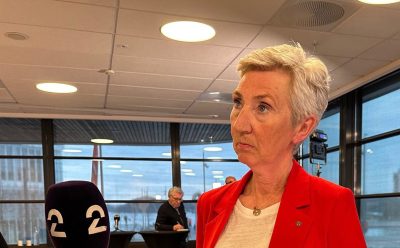Norwegian labour leaders and employers’ representatives fundamentally disagree over whether a 5.2 percent wage increase would have given workers the “real pay growth” they sought. Reports last week of a surprising jump in the current inflation rate, to 6.5 percent, didn’t help, but it’s arguably the double-digit increases in top management compensation that prompted trade union federations to break off talks and call 25,000 workers all over the country out on strike this week in a wide variety of sectors.

The strike was already halting ferries Monday morning, closing large retail establishments, shutting down production at everything from breweries to offshore construction firms and blocking distribution of imports including new cars. It’s the first time since World War II that Norway’s labour federations have called a strike over pay alone, and it will spread later this week if employers don’t come back with a better offer.
The battle between management and workers flared on state broadcaster NRK’s popular morning radio program Politisk kvarter, with labour leader Jørn Eggum of Fellesforbundet blasting the “bonus bonanza” enjoyed by executives at many of Norway’s highly profitable companies, and industrial employers’ leader Stein Lier-Hansen of Norsk Industri suggesting the labour leaders are just seeking “revenge.” At issue, though, is how executives routinely receive huge bonuses tied to profits on top of multi-million-kroner salaries, a practice that resulted in total compensation increases as high as 20 percent of even more last year. Workers, meanwhile, haven’t seen real wage growth for the past two years, longer in many sectors. Their purchasing power has declined, and labour leaders think it’s time for that to stop.

“The gap between the numbers that were offered on paper, and what our members actually would have received, is what I call ‘play money,'” the leader of Norway’s largest trade union federation LO, Peggy Hessen Følsvik, said Monday morning. She wouldn’t confirm the 5.2-percent wage offer believed to have been leaked by employers’ representatives after mediation broke down late Sunday, 16 hours into overtime.
Følsvik claimed, however, that it only would have been a “good result” if it actually would have given workers a real pay hike of 5.2 percent with the according rise in purchasing power. “I would have come running to the bargaining table,” Følsvik said, “but it wouldn’t, and therefore we said ‘no.'”

Lier-Hansen, speaking on behalf of industrial employers now facing a nationwide strike by angry workers, disagrees. “I believe (the offer that LO and trade union federation YS rejected) would have led to real pay growth for everyone,” he told Norwegian media on Monday. He claimed the employers have “never come close to offering such a large amount” in terms of actual kroner, and that it was more than the 4.9 percent estimated price-rise for 2023 that had been accepted by both sides when labour negotiations first began a few weeks ago.
Newspaper Aftenposten and TV2 have reported that the alleged 5.2 percent offer broke down into a “central” raise for all workers of 1.9 percent, an additional raise of 1.4 percent plus local raises of 1.9 percent (to reflect regional pay differences). Eggum of Fellesforbundet claims that not all LO-organized workers would emerge on the plus-side.

It was up to state mediator Mats Wilhelm Ruland to try to bring the two sides together, after initial talks between LO and national employers’ organization NHO broke down last week. Mediation began Friday with a midnight deadline for Saturday. It was, as usual, extended well into Sunday, but Ruland was already warning early Sunday morning that negotiations were unusually difficult.
NHO has argued all along that it understood that many workers are currently caught in “demanding times” given the steep increases in not only retail prices and electricity rates but also interest rates. NHO leader Ole Erik Almlid also insisted that its proposal for a settlement was aimed at fending off a strike.
“This in an unnecessary strike,” Almlid claimed after LO broke off mediation. “We said ‘yes’ to a proposal that would have given LO’s members increased purchasing power.” He objected to LO’s claims that NHO rejected its purchasing power demand and now fears the strike will harm both businesses and jobs.
The “conflict,” as both sides prefer to call it, has ended in the biggest nationwide strike in years, with Følsvik claiming that it will continue “for as long as necessary.” A total of around 23,000 LO-organized workers were called out immediately plus 1,500 YS-organized. Another 15,000 LO members and 500 YS members will be called out on strike from Friday.
Actual strikes fan out over a wide range of businesses nationwide, from the Mondelez Freia chocolate factory in Oslo and Nidar candy-maker in Trondheim to a wide range of breweries and soft-drink makers nationwide, electricians and asphalt workers, IKEA stores in the Oslo area, automobile importers, Posten’s Bring delivery firms, offshore firms including Aker Solutions and the Grand- and Radisson Plaza hotels in Oslo. Ferry companies have also been hit including most running in Oslo, Tromsø and in the Stavanger and Bergen areas. Ferry service isn’t entirely shut down yet, but there are far fewer departures and reduced frequency.
Prime Minister Jonas Gahr Støre from the Labour Party called the strike “serious” and “unfortunate” but told NRK that he needed to be “careful” about commenting on labour leaders’ demands for increased purchasing power. “That’s the responsibility of the two sides (LO and the employers’ umbrella organization NHO),” Støre told NRK, adding that his government “respects” the rules for how collective bargaining functions in Norway.
“I can understand that this is demanding … but strikes are a legal tool,” Støre said. His government has repeatedly been called upon to lower Norway’s 25 percent value-added tax on most goods and most services, as a means of increasing purchasing power at the grocery store, for example, where food prices have soared. His government has so far refused to do so, with Støre pointing instead to state compensation for high electricity rates and noting that food prices in Norway haven’t climbed as high as they have in other countries.
NewsinEnglish.no/Nina Berglund

